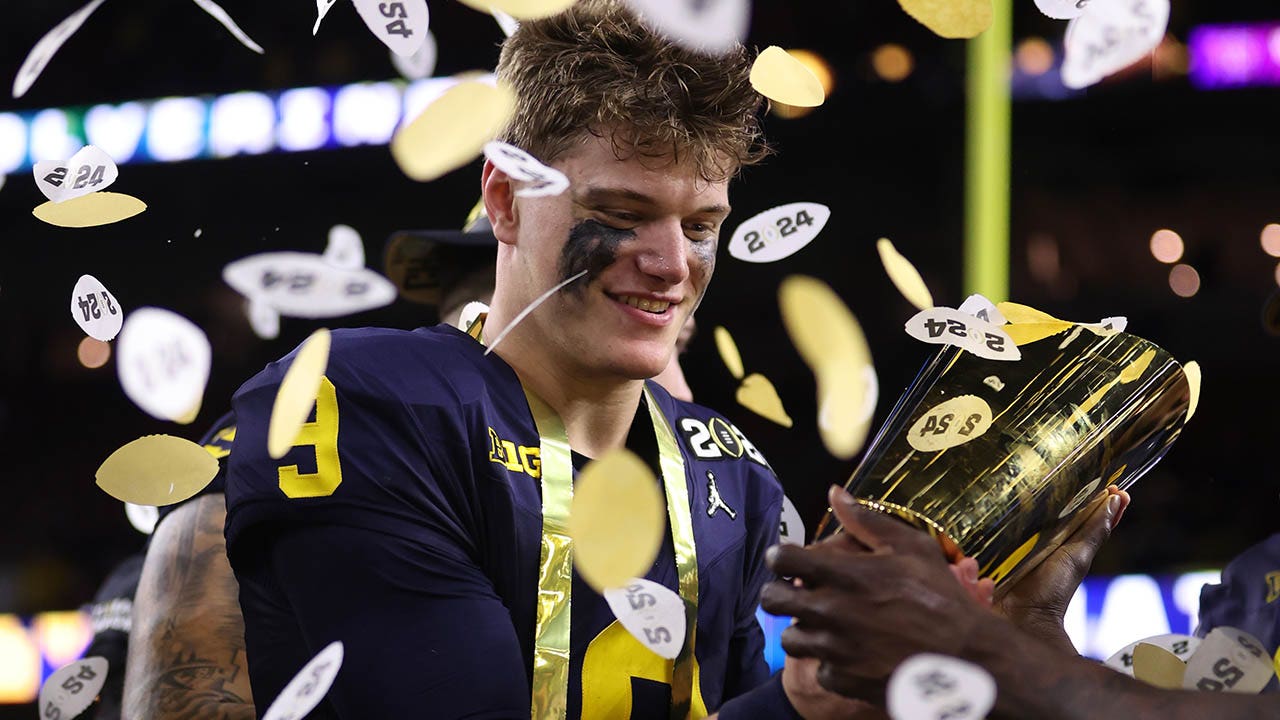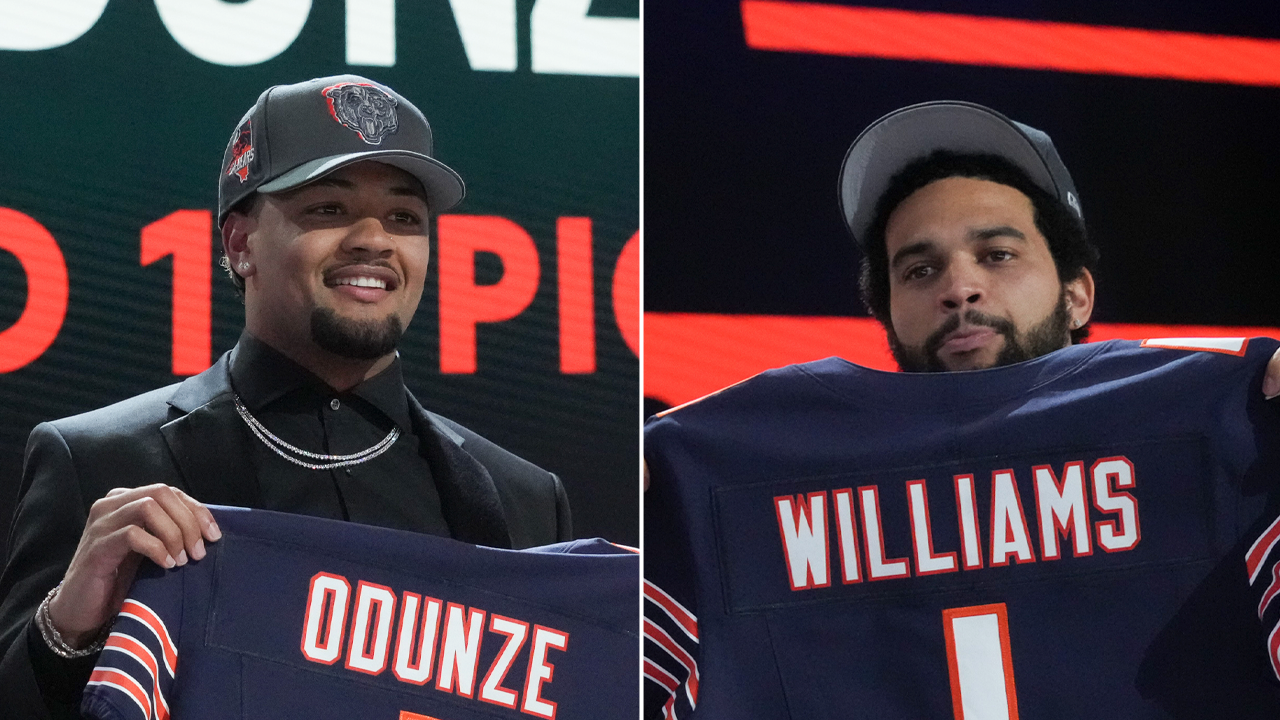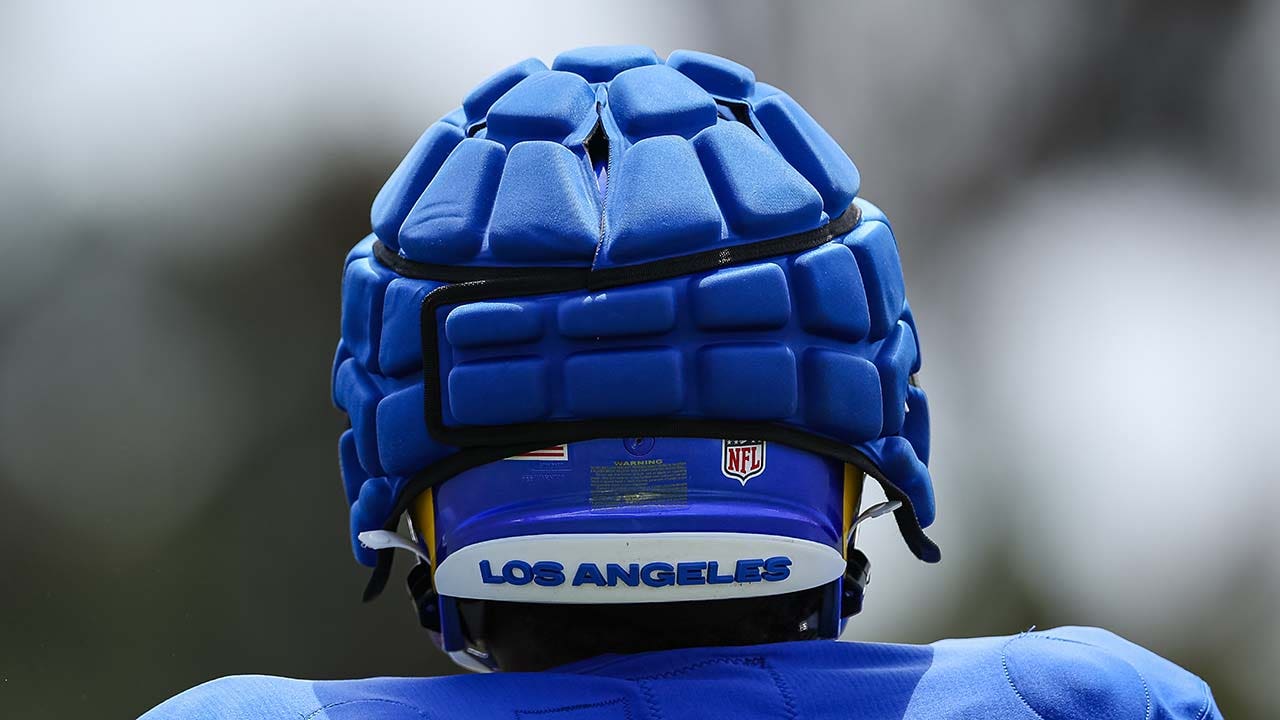
It didn’t take longer than a week or two for the idea to proliferate across the league.
Early in the second quarter of their Week 1 game against the Los Angeles Chargers, Miami Dolphins head coach Mike McDaniel called a short out motion to set up a 28-yard catch for receiver Tyreek Hill.
The motion element of the play was new to many, a truncated version of a longer-developing pre-snap jet motion that features a player running behind and across the formation before he bursts upfield at the snap. This short motion sent Hill outward — not inside or across — after a signal from the quarterback. He then turned to run vertically at the snap of the ball instead of having to first get across the formation, sprinting about 15 yards downfield before breaking inward for the catch in the middle of the field.
The motion spread rapidly across the NFL, at first and especially among the coaching family to which McDaniel belongs. The Rams, under head coach Sean McVay, started running these motions by Week 2 in a game against the San Francisco 49ers, coached by Kyle Shanahan, and vice versa. Zac Taylor’s Cincinnati Bengals ran it by Week 3. By midseason, the Green Bay Packers, coached by Matt LaFleur, used the concept against the Rams.
Current Falcons head coach Raheem Morris, a former colleague of all of them, joked in November that McDaniel, Shanahan and McVay would have to fight over credit for the concept’s inception as quickly as it blazed into a leaguewide trend.
At the end of the 2023 season, some version of the short out motion was in the playbooks of most, if not all, teams that frequently utilized pre-snap motion. “We call it ‘cheat’ because it’s cheating,” Shanahan said in September. “It’s cool to get ’em running sideways, and still hit it vertically.”
In football, ideas form in one building, are borrowed by another and continue to evolve based on a team’s personnel and staff. Some concepts are solved by scheme; others are “unsolvable” because of the abilities of the players who run them. With the help of technology and a generation of coaches and players driven toward innovation, that cycle happens faster than ever.
Hill’s speed brought Miami’s version of “cheat” to life. He could run any type of route out of it, including the in-breakers that capitalized on recently vacated space in the middle of the field.
Nobody else had Hill, but everybody else wanted to see if they could apply the motion, and variations of it, to players with different skill sets. Even players without elite speed could get open off the line of scrimmage when running this short out motion because it can open up space behind another offensive player — a “rub” — nearly simultaneously with the snap.
Meanwhile, defensive coaches agonized over ways to stop it.
When reporters asked McDaniel where he came up with the motion in September, he told them he was “just bored.” The real answer is more layered.
The Dolphins’ passing attack is predicated on timing, and the elite speed possessed by both Hill and fellow receiver Jaylen Waddle means even deeper route concepts have quick-throw potential. Quarterback Tua Tagovailoa’s average time to throw last season was league-fastest at 2.36 seconds, according to Next Gen Stats, yet Miami’s offense ranked second in pass yards per attempt (8.3).
Defenses worked to contain the Dolphins’ explosive passing attack in different ways. Some tried jamming Hill off the line to disrupt or delay his timing or using other techniques to try to move receivers off their route patterns and landmarks. Some teams put a wide, hard-to-navigate shell over the defensive backfield and hoped they could harass Tagovailoa with only four pass rushers or force him to take shorter completions under that shell.
Miami, like many other teams across the NFL, already deployed jet motions. Using different cadences, calls and signals, Tagovailoa could time the snap so the player in motion could cut upfield and get space off the line of scrimmage as well as a head start into running full speed. But those motions ultimately require players to cover a significant amount of horizontal yardage before their routes even begin.
Every NFL offensive playbook contains at least one form of pre- and at-snap motion, the use of which has especially increased over the last seven years. Seventeen of the NFL’s 32 teams utilized motion on at least 50 percent of offensive snaps in 2023, ESPN analytics found, with some of the league’s top offenses — the Dolphins, Rams, 49ers, Chiefs, Green Bay Packers and Detroit Lions — using it most frequently.
Source: ESPN Stats & Info
Simpler motions reveal whether a defense is in man or zone coverage, but some modern defenses disguise their “man/zone indicators,” thus nullifying the intent of an information-gathering motion. More advanced motions create multiple advantages at once, providing information about the defense while also manufacturing leverage and space.
For example, this Kansas City Chiefs motion, combined with a run/pass option (RPO), helps show a defense’s coverage based on defender movement. It may also help the quarterback alert to pressure.
Most importantly, the motion changes the formation to determine whether the offense will get a numbers advantage against either downfield defenders (pass), or box defenders (run). Quarterback Patrick Mahomes sees he has one less defender to tie up his receivers if he decides to pass because that defender shows he will play the run during the pre-snap motion.
(Drew Jordan / The Athletic)
The Rams utilize motion in their pass and run game with a variety of receivers and tight ends (so do the 49ers, Packers and others). These motions do everything from switching the front and back sides of formations, creating space and leverage for speed players, disguising run concepts and possibly even disguising a quarterback’s “can” — an alert to audible to the second or third of multiple plays sent through the headset pre-snap.
And sometimes these motions do all this at once.
In the Rams’ passing game, motion can help disguise roles on a given play. Receivers can run motions that make defenders believe they will behave like a fullback or tight end based on alignment, then run a typical receiver’s route after the snap.
“What Mike McDaniel has been doing in Miami, everybody is copying it,” LaFleur said in early November. “What the Rams are doing with guys like Puka (Nacua), they’re essentially getting him in a position and then he becomes a fullback, yet he might run a deep over on you …
“It definitely has changed the game quite substantially, in my opinion.”
Most modern offenses feature player/coach partnerships with a mutually understood intent behind their motions. It starts with an idea, and in some NFL buildings, those can come from anywhere. In the case of “cheat,” McDaniel’s idea didn’t look like it came from the NFL at all.
When Hall of Fame Canadian Football League executive Danny McManus and pro scout Sammy Gahagan attended a Dolphins training camp practice together in Miami Gardens, Fla., last summer, they felt a philosophical kinship with all of the pre- and at-snap movement they observed.
“I kind of thought, ‘That looks eerily familiar,” Gahagan said. “I had one of the scouts from Miami talk to me about it, and he goes, ‘Coach McDaniel has been kind of brushing up on his CFL work.’ I was like, ‘Oh, that’s why this is all starting to look familiar.’ Because for us, all we do is watch people in motion!”
To eyes accustomed to watching CFL offenses, everything the NFL does with motion looks a bit static. In the CFL, as many as five of 12 offensive players can move outward, inward and toward the line of scrimmage before the snap. NFL motion rules prohibit vertical movement until the ball is snapped, as well as multiple simultaneous motions.
“Cheat” almost looked like it was bending those rules, or at the very least drawing inspiration from the Northern game.
(Drew Jordan / The Athletic)
In this clip, the short, fast motion sends Hill outside and behind another receiver, creating the “rub” for his defender milliseconds before the ball is snapped.
The combination of the rub and Hill’s running start makes it almost impossible for a defender to regain proper leverage or make meaningful contact. According to Amazon/Next Gen Stats, which analyzed this clip using its in-game player tracking technology, Hill reached 7.71 miles per hour as the ball was snapped and 16.04 mph as he crossed the line of scrimmage. Hill’s maximum speed on the play was 18.98 mph — so he reached near top speed right off of the line.
“If we’re able to use our speed vertically without allowing the (defensive back) to get hands on us, that helps us a lot,” Hill said in December. “Remember, offense is about timing and placement of the ball. If a (defensive back) is allowed to get his hand on us, dictate us or push us off our landmark … the play is dead at that point.”
It is difficult for defenders to pass off help to one another pre-snap against “cheat” like they sometimes can with a longer motion. Help has to happen post-snap and at speed, and there are other eligible receivers to defend, making it more disruptive to an NFL defense than typical motion plays.
“It displaces the drops of everybody else,” McManus said. “They are creating more space in a 53-yard field just like we try to eat up a lot of space in our 65-yard field.”
Over seemingly endless reps last summer, Tagovailoa and the offense timed the concept so that the motion player could legally cut upfield right at the snap. As a shorter motion, “cheat” requires a different pre-snap sequence and post-snap dropback, both of which can change further depending on the route pairing. Eventually, the Dolphins ran the concept in a joint practice with the Falcons in mid-August, the closest they could get to running it in a game-like scenario while still keeping the motion a relative secret. And secrecy was important.
Many organizations task pro scouting department staff with combing through social media, videos of open practices posted by fans, beat writer reports, press conference videos posted on team websites and even Reddit threads for intel that could help gain an advantage. Then, when the season begins, all NFL teams receive copies of each others’ game film.
During a typical game week, that footage is uploaded into the team’s video archiving and sorting system late Sunday night. The software then filters plays into different buckets — run plays, pass plays, down and distance, red zone, etc. Game planning generally must be completed by Tuesday, before the first Wednesday morning installation meeting with players, so all of the film from the upcoming opponent, plus the selected buckets of plays from around the league, must be absorbed by coaches by then.
There’s also an explosive reel, which features run plays that gained 10- or 12-plus yards and pass plays that gained 20-plus yards. This is the film many coaches like to watch first, and it’s where the Dolphins’ 28-yard play — featuring “cheat” — landed late Sunday night after Week 1.
By that Monday morning, most head coaches — and many assistants — had seen the motion. By Tuesday, it was in the Week 2 game plan for the Rams, 49ers and others. By late September, NFL analysts across the sport were buzzing about it. As the 2023 season continued, coaches didn’t just see new variants of “cheat” but also different strategies to defend it and other motions.
Backup quarterback Mike White runs the Dolphins’ scout team. As part of a weekly assignment, he receives play cards from defensive coaches illustrating the plays they believe the opposing offense will use against Miami in the upcoming week to then run against the first-team defense in practice. By November, White frequently saw plays he recognized as versions of Miami’s own coming up on his cards.
A pro personnel executive for a team who was not authorized to speak publicly said that even his coaches, who did not face the Dolphins in 2023, put “cheat” on their scout-team cards because they knew it would eventually come up from an opponent who was on their schedule.
A defensive assistant coach who game-planned against Miami last season came up with different ways to push the motion player to the perimeter and keep him there, in an attempt to cut off any in-breaking routes. The problem? “Cheat” was relatively new, and some defensive countermoves could deviate from defensive coaches’ coverage rules against other motions. A team has only two or three days of practice to install any type of counter. When planning against teams that could run multiple routes off “cheat,” quick-patch solves only helped so much.
Defensive coaches and players said they started to see subtle attempts to disrupt the timing of skill players at a different part of the route — knowing they couldn’t right off the line of scrimmage.
“You’ve got to get hands on them as quick as you can,” McManus said. “Whether someone, now, starts running with that guy as he’s in motion, doing that exit motion, and just buries him into the sideline. … You’ve got to try to blow it up some way. I can see them start getting more physical with it, but you are (still) taking the chance that somebody will go right past you.”
It was no coincidence that the best defenses in the league in 2023 featured versatile players with disciplined eyes against motion, hard-to-discern pressure — or simulated pressure — and post-snap defensive back rotations aimed at making quarterbacks hesitate in their decision-making even if they had an initial advantage gained with pre and at-snap motion.
“I’m sure that will be everybody’s offseason project. We’ll have to adjust somehow,” said White, smiling. “Every time someone has success, that’s everyone else’s offseason project. ‘I’m gonna figure out how to stop that.’”
Each spring, coaches watch a vast amount of film cut-ups from all over the league as they complete their own teams’ evaluations and prepare for free agency. Eventually, everybody watches all of the explosive plays. That’s how many coaches get their ideas, see how defenses are playing certain concepts, and discover gadget plays.
LaFleur, for example, had two large computer screens and a wall-mounted flat screen with clips of offensive plays from the Dolphins, 49ers and Chiefs pulled up in his office last spring, while speaking with The Athletic for “The Playcallers” series.
“I’m not too ashamed to say that I steal from anybody if I think it’s a good idea, I don’t care,” said LaFleur, grinning. “I’m trying to get inspiration from watching others and how they use maybe a specific player or, you know, to try to come up with plays or ideas that are going to help our players be their best.”
As ideas spread around the league faster than ever, coaches know they have to look where others may not be looking. Through their video sorting technology and staff, some coaches even watch “failed” plays — snaps where a formation, concept and motion are clear, but an error happens or the play is stopped after minimal gain or even a loss.
“Some of the best things you might see are the things that don’t end up working out but you can see the intent behind it,” McVay said. “If you sort it by just the positive gains, that’s the only stuff that you end up seeing. …
“It’s a delicate balance, though, because you can go down a rabbit hole where you’re chasing a lot of things”
Other coaches keep years-long logs of what worked for them in a singular moment, stashing an idea until the perfect time to re-use it arises.
An inside/outside speed motion on the Super Bowl-winning touchdown catch by Kansas City Chiefs receiver Mecole Hardman was nicknamed “Tom and Jerry.” Chiefs head coach Andy Reid had run the motion in the previous year’s Super Bowl by another name: “Corn dog.”
Thirty-one other head coaches watched him do it. Suddenly an idea was new again. Again.
Zak Keefer and Nate Tice contributed to this report.
GO DEEPER
Making sense of NFL’s new kickoff rule and what it means for next season
(Illustration: Dan Goldfarb / The Athletic; Megan Briggs, Ryan Kang, Thearon W. Henderson / Getty Images)









